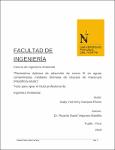In Vitro Effect of Molasses Concentration, pH, and Time on Chromium Removal by Trichoderma spp. from the Effluents of a Peruvian Tannery

View/
Descargar
(application/pdf: 634.1Kb)
(application/pdf: 634.1Kb)
Date
2023-05-19Author(s)
Tello Galarreta, Fabricio A.
Durand Paz, Juan H.
Rojas Villacorta, Walter
Cabanillas Chirinos, Luis
De La Cruz Noriega, Magaly
Nazario Naveda, Renny
Benites, Santiago M.
Rojas Flores, Segundo
Metadata
Show full item recordAbstract
The effluents generated by the tannery industry have a high content of chromium and other toxic elements, representing a potential threat to ecosystems. An eco-friendly alternative to treat these effluents is the use of microorganisms, such as fungi, with the capacity to biosorb heavy metals. The present work aims to determine the effect of the molasses concentration, pH variation, and time on the removal of total chromium using the filamentous fungus Trichoderma spp. An experimental design was adopted using pH (4 and 6), concentrations of molasses (0.5 and 1%), and time (8 and 12 days) as independent variables. The Trichoderma inoculum was constant in all the treatments. The different treatments were evaluated after 0, 8, and 12 days by taking 50 mL of sample from each bioreactor. The chromium concentration was subsequently determined in each sample. The results show that treatment 3 (1% molasses and pH 4) showed higher chromium removal after both 8 and 12 days. The concentrations of total chromium decreased from 665 mg/mL to values of 568 mg/mL by day 8 and 486 mg/mL by day 12. These values are, however, still above the maximum threshold imposed by Peruvian law regarding the discharge of non-domestic effluents into the sewage system. The results show that Trichoderma spp. can increasingly remove chromium from the effluent with longer incubation periods. However, future studies are necessary to determine the mechanisms of chromium biosorption by the fungus and the influence of other physicochemical parameters.
Mostrar más
Bibliographic citation
Tello, F. A., Durand, J. H., Rojas, W., Cabanillas, L., De La Cruz, M., Nazario, R., Benites, S. M., & Rojas, S. (2023). In Vitro Effect of Molasses Concentration, pH, and Time on Chromium Removal by Trichoderma spp. from the Effluents of a Peruvian Tannery.
Processes, 11, 1-11. https://doi.org/10.3390/pr11051557
Collections
The following license files are associated with this item:
Related items
Showing items related by title, author, creator and subject.
-
Parámetros óptimos de adsorción de cromo III en aguas contaminadas mediante biomasa de cáscara de maracuyá Passiflora edulis
Campos Flores, Gaby Yud Nery (Universidad Privada del Norte, 2019-06-24)Acceso cerradoEn la industria el uso del agua y metales ha aumentado, y, por tanto, la generación de residuos líquidos con alto contenido de metales. Por este motivo se ha estudiado los parámetros óptimos de adsorción de cromo III ... -
Moringa oleífera lam liofilizada como agente coagulante en la remoción de sólidos totales y demanda química de oxígeno en efluente de curtiembre
Aguilar Villanueva, Freesy Yanira (Universidad Privada del Norte, 2019-06-18)Acceso abiertoLa presente investigación tuvo como finalidad evaluar el efecto de la Moringa oleifera Lam. Liofilizada como agente coagulante en la remoción de Sólidos Totales y la Demanda Química de Oxigeno en efluente de Curtiembre, ... -
Passion-fruit shell biomass as adsorbent material to remove chromium III from contaminated aqueous mediums
Campos-Flores, Gaby; Gurreonero-Fernández, Julio; Vejarano, Ricardo (IOP Publishing, 2019-11-19)Acceso abiertoABSTRACT The aim of the study was to evaluate an adsorbent material based on passion-fruit shell biomass (PFSB) for chromium III removal from contaminated aqueous mediums, composed of distilled water and different ...





